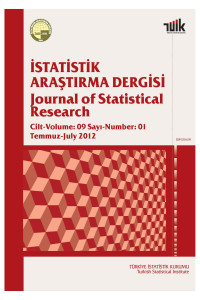Abstract
Keywords
Binary dependent variable Covariates of nonresponse Logistic regression Nonresponse error components Proxy response
References
- Agresti, A., (2002). Categorical Data Analysis. 2nd edition. John Wiley, Hoboken, NJ.
- Allen, J. and Le, H., (2008). An Additional Measure of Overall Effect Size for Logistic Regression Models. Journal of Educational and Behavioral Statistics 33, 416 - 441.
- Ayhan, H. Ö., (1981). Sources of Nonresponse Bias in 1978 Turkish Fertility Survey. Turkish Journal of Population Studies 2-3,104-148.
- Ayhan, H. Ö., (1998). Survey Nonresponse Models and Applications in Turkey. In Official Statistics in a Changing World. Stockholm: Statistics Sweden Press, pp. 155-158.
- Chatterjee, N., (2004). A Two Stage Regression Model for Epidemiological Studies with Multivariate Disease Classification Data. Journal of the American Statistical Association 99, 127 - 138.
- Cox, D. R. and Oakes, D., (1984). Analysis of Survival Data. Chapman and Hall, London.
- Hosmer, D. W., and Lemeshow, S., (1980). A Goodness-of-Fit Test for the Multiple Logistic Regression Model. Communications in Statistics A 10, 1043-1069.
- Hosmer, D. W., and Lemeshow, S., (2000). Applied Logistic Regression (Second Edition). New York: John Wiley and Sons, Inc.
- HUIPS., (2004). Turkey Demographic and Health Survey, 2003. Hacettepe University Institute of Population Studies, Ministry of Health General Directorate of Mother and Child Health and Family Planning, State Planning Organization and European Union. Ankara, Turkey. 309 pp.
- Le, H. and Marcus, J., (2012). The Overall Odds Ratio as an Intuitive Effect Size Index for Multiple Logistic Regression: Examination of Further Refinements. Educational and Psychological Measurement 76(6),1001 - 1014.
- Lemeshow, S., and Hosmer, D. W., (1982). The Use of Goodness-of- Fit Statistic in the Development of Logistic Regression Models. American Journal of Epidemiology 115, 92-106.
- Lemeshow, S., and Hosmer, D. W., (1983). Estimation of Odds Ratio with Categorical Scaled Covariates in Multiple Logistic Regression Analysis. American Journal of Epidemiology 119,147-151.
- Lyles, R. H., Guo, Y., and Greenland, S., (2012). Reducing Bias and Mean Squared Error Associated with Regression-Based Odds Ratio Estimators. Journal of Statistical Planning and Inference 142, 3235-3241.
Hanehalkı Araştırmalarında Yerine Cevaplayıcıdan Elde Edilen Birim Cevaplanmama Hatası Ortak Değişkenlerinin Bileşenleri
Abstract
Keywords
Cevaplanmama hatası bileşenleri Cevaplanmama ortak değişkenleri Kesikli bağımlı değişken Lojistik regresyon Yerine cevaplama
References
- Agresti, A., (2002). Categorical Data Analysis. 2nd edition. John Wiley, Hoboken, NJ.
- Allen, J. and Le, H., (2008). An Additional Measure of Overall Effect Size for Logistic Regression Models. Journal of Educational and Behavioral Statistics 33, 416 - 441.
- Ayhan, H. Ö., (1981). Sources of Nonresponse Bias in 1978 Turkish Fertility Survey. Turkish Journal of Population Studies 2-3,104-148.
- Ayhan, H. Ö., (1998). Survey Nonresponse Models and Applications in Turkey. In Official Statistics in a Changing World. Stockholm: Statistics Sweden Press, pp. 155-158.
- Chatterjee, N., (2004). A Two Stage Regression Model for Epidemiological Studies with Multivariate Disease Classification Data. Journal of the American Statistical Association 99, 127 - 138.
- Cox, D. R. and Oakes, D., (1984). Analysis of Survival Data. Chapman and Hall, London.
- Hosmer, D. W., and Lemeshow, S., (1980). A Goodness-of-Fit Test for the Multiple Logistic Regression Model. Communications in Statistics A 10, 1043-1069.
- Hosmer, D. W., and Lemeshow, S., (2000). Applied Logistic Regression (Second Edition). New York: John Wiley and Sons, Inc.
- HUIPS., (2004). Turkey Demographic and Health Survey, 2003. Hacettepe University Institute of Population Studies, Ministry of Health General Directorate of Mother and Child Health and Family Planning, State Planning Organization and European Union. Ankara, Turkey. 309 pp.
- Le, H. and Marcus, J., (2012). The Overall Odds Ratio as an Intuitive Effect Size Index for Multiple Logistic Regression: Examination of Further Refinements. Educational and Psychological Measurement 76(6),1001 - 1014.
- Lemeshow, S., and Hosmer, D. W., (1982). The Use of Goodness-of- Fit Statistic in the Development of Logistic Regression Models. American Journal of Epidemiology 115, 92-106.
- Lemeshow, S., and Hosmer, D. W., (1983). Estimation of Odds Ratio with Categorical Scaled Covariates in Multiple Logistic Regression Analysis. American Journal of Epidemiology 119,147-151.
- Lyles, R. H., Guo, Y., and Greenland, S., (2012). Reducing Bias and Mean Squared Error Associated with Regression-Based Odds Ratio Estimators. Journal of Statistical Planning and Inference 142, 3235-3241.
Details
| Primary Language | English |
|---|---|
| Subjects | Statistics |
| Journal Section | Research Articles |
| Authors | |
| Publication Date | July 13, 2012 |
| Published in Issue | Year 2012 Volume: 9 Issue: 1 |


